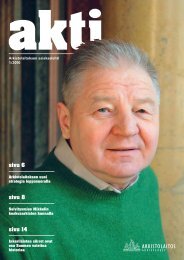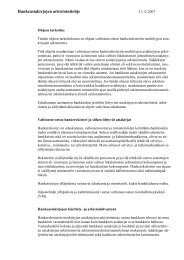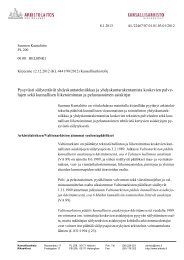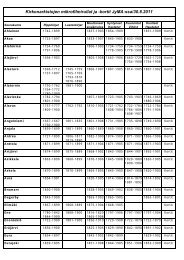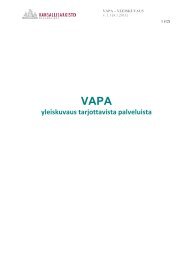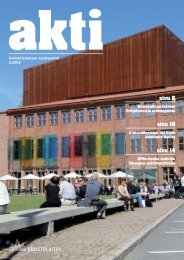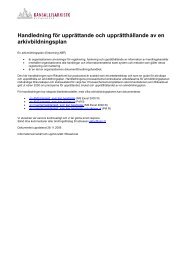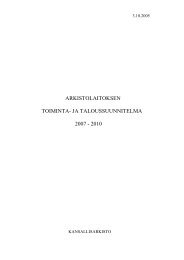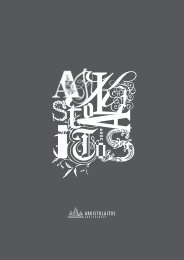- Page 1 and 2:
IDEN LAPSET GERMAN SOLDIERS 40-1948
- Page 3 and 4:
Kansikuva: Saksalaisen aliupseeri j
- Page 5 and 6:
Stabbed Through the Heart Relations
- Page 7 and 8:
Tekijä kiittää niitä saksalaist
- Page 9 and 10:
Väestötilastot ja ulkomaalaisten
- Page 11 and 12:
Avioituminen, eroaminen ja sotalesk
- Page 13 and 14:
palvelusmaidensa naisista. Toisessa
- Page 15 and 16:
Kinderlandverschickung -järjestön
- Page 17 and 18:
mainittiin tosin sota-avioliittojen
- Page 19 and 20:
ekisteröimiseksi edellytettiin 18
- Page 21 and 22:
lukemalla kuulutus vain yhden kerra
- Page 23 and 24:
kuukausipalkka. Lisäksi oli mahdol
- Page 25 and 26:
edistää ruotsinkielisen väestön
- Page 27 and 28:
noin 41 000 etupäässä 18-40-vuot
- Page 29 and 30:
Sotilaan Äänen strippi heinäkuul
- Page 31 and 32:
Tunkelon selostuksessa avioliiton o
- Page 33 and 34:
on myös Helsingistä sekä Kemijä
- Page 35 and 36:
kotiinsa lomalle. Kotona hän yllä
- Page 37 and 38:
avioeroon. Oulun läänin Siikajoel
- Page 39 and 40:
Taulukko 3. Elävänä syntyneet av
- Page 41 and 42:
Kuolleena syntyneet lapset jakaantu
- Page 43 and 44:
Kuolleena syntyneiden au-lasten osa
- Page 45 and 46:
lähes pelkästään vuorolomilla,
- Page 47 and 48:
kanssa sen perusteella, että näm
- Page 49 and 50:
koko maassa sikiönlähdettäjiä o
- Page 51 and 52:
suorittanut raskaudenkeskeytyksen.
- Page 53 and 54:
joitakin yksittäisiä paikkakuntia
- Page 55 and 56:
Oulun lääni Kunta 1939 1940 1941
- Page 57 and 58:
syntyi 1 118 au-lasta, oli vastaava
- Page 59 and 60:
sijoitettiin jatkosodan vuosina neu
- Page 61 and 62: samalla jopa 16,1 %:lla. Myös synt
- Page 63 and 64: antanee kuitenkin joitakin viitteit
- Page 65 and 66: Tanskassa kondomista oli tullut lai
- Page 67 and 68: upseereille. Armeija hankki myös s
- Page 69 and 70: se olisi ehkäissyt tartunnan. Lis
- Page 71 and 72: varmuusesineitä myytiin joko tiski
- Page 73 and 74: Avioerot. Varsinaisina sotavuosina
- Page 75: Liite 1. Aviolapset ja au-lapset l
- Page 87 and 88: Liite 3. Luettelo Vaasan läänin k
- Page 89 and 90: Museovirasto - Helsingin yliopiston
- Page 91 and 92: Leben” - Zeitschrift für christl
- Page 93 and 94: Junila, Marianne: Kotirintaman asev
- Page 95 and 96: Nieminen, Armas: Taistelu sukupuoli
- Page 97 and 98: Valvanne, Leena: Syntyvyyden sään
- Page 99 and 100: 1,5 miljoner barn födas per år i
- Page 101 and 102: illegitimate children born in the 2
- Page 103 and 104: data in the table does not support
- Page 105 and 106: that the total number remained unde
- Page 107 and 108: However, one useful source of mater
- Page 109 and 110: ut the birth rate for the number of
- Page 111: about condoms for their part, and t
- Page 115 and 116: not play a very significant role in
- Page 117 and 118: Avioliitot ja kihlaukset rotupoliti
- Page 119 and 120: Norjan tutkimus. Kirjoitus perustuu
- Page 121 and 122: lisäksi valtakunnalliset Uusi Suom
- Page 123 and 124: annettiin 7.5.1940, kuukausi Tanska
- Page 125 and 126: syntiinlankeemus, kun arjalainen he
- Page 127 and 128: Norjassa sovelletut avioliittokäyt
- Page 129 and 130: hiljaisella kannatuksella enemmän
- Page 131 and 132: hän joutui pyörällä vierailemaa
- Page 133 and 134: Eräs naimisiin menneistä, saksala
- Page 135 and 136: tulevaisuutta koskeva velvoite. Tä
- Page 137 and 138: useilla pistimenpistoilla ja vielä
- Page 139 and 140: Germanische Leitstelle Freiwilligen
- Page 141 and 142: ongelmia ja ikävyyksiä. Taustana
- Page 143 and 144: Syksyllä 1944 värvättyihin suoma
- Page 145 and 146: pienempi etäisyys kuin Venäjän s
- Page 147 and 148: Albertus -yliopistossa 500 kuunteli
- Page 149 and 150: huolimatta kuitenkin esille taipumu
- Page 151 and 152: Suomen itäisille rajoille suomalai
- Page 153 and 154: kirjoittajat olleet löytäneet lä
- Page 155 and 156: ”finnische (uralaltaische)” Cha
- Page 157 and 158: Taulukon tietojen mukaan hakemuksia
- Page 159 and 160: jatkosodanaikaisten vihkimisluettel
- Page 161 and 162: Muutamissa tapauksissa solmittiin a
- Page 163 and 164:
aineistossa on tosin joitakin maini
- Page 165 and 166:
Pariskunta olisi halunnut mennä he
- Page 167 and 168:
vaikuttajatahoihin. Myös kihlaukse
- Page 169 and 170:
Olen myös todennut, että esitetyi
- Page 171 and 172:
Museoviraston kysely. Suomalaisen n
- Page 173 and 174:
Forsell, Per: Barnavårdsinstitutet
- Page 175 and 176:
Sammallahti miessemánu 21. beaivve
- Page 177 and 178:
Harnackhaus får sin första utlän
- Page 179 and 180:
These marriages might lead to divid
- Page 181 and 182:
Once the permit application made it
- Page 183 and 184:
permits, and ultimately Hitler hims
- Page 185 and 186:
A total of 89 of the men in questio
- Page 187 and 188:
Saksalaisten sotilaiden lapset Äit
- Page 189 and 190:
Kaunokirjallisuus. Saksalaisten sot
- Page 191 and 192:
laajoja muistiinpanoja havainnoista
- Page 193 and 194:
sijaan suhteellisen vähän ja aino
- Page 195 and 196:
ja kampaajia 195, yms. Suurin yksit
- Page 197 and 198:
maksettiin elatusta ja synnytykseen
- Page 199 and 200:
Suomen virallisten suhteiden katkea
- Page 201 and 202:
vaihtamillaan tavaroilla j.n.e. Nai
- Page 203 and 204:
avioliiton ulkopuolella syntyneiden
- Page 205 and 206:
von Bonin, ja lausui mm.: ”Meille
- Page 207 and 208:
Taulukko 4. Elatusapua hakeneiden
- Page 209 and 210:
Taulukosta ilmenee, että äidit to
- Page 211 and 212:
Taulukko kuvaa ainoastaan elatusapu
- Page 213 and 214:
Alue Tutustumispaikka Lasten syntym
- Page 215 and 216:
Taulukon vuosijakauma muistuttaa jo
- Page 217 and 218:
Sotilasarvolla mainituista sotilais
- Page 219 and 220:
siviilielämässään suhteellisen
- Page 221 and 222:
1943 ainoastaan noin 25 000 miestä
- Page 223 and 224:
Seurustelevien kielitaito Missä m
- Page 225 and 226:
Monet seurustelevat saksalaiset sot
- Page 227 and 228:
huhujen mukaan ”isällä oli jo p
- Page 229 and 230:
näyttivät pyydystelevän majuria.
- Page 231 and 232:
tai muiden lähisukulaisten ja tutt
- Page 233 and 234:
vaimo seurusteli saksalaisen upseer
- Page 235 and 236:
vaihtaa niitä itselleen vastapalve
- Page 237 and 238:
Lopuksi myös kulutushyödykkeitä
- Page 239 and 240:
Eräät Saksaan päätyneet suomala
- Page 241 and 242:
kerittiin paljaspäiksi. Konttajär
- Page 243 and 244:
lapset”. Sodan jälkeen nainen me
- Page 245 and 246:
Saksalainen täti järjesti perheel
- Page 247 and 248:
molemmat kuolivat vauvoina. Seuraav
- Page 249 and 250:
äideillä oli mahdollisuus käydä
- Page 251 and 252:
mielekästä, sillä ne tietyt elä
- Page 253 and 254:
Myös julkaistussa kirjallisuudessa
- Page 255 and 256:
kertoo siitä: ”mummo ja pappa ra
- Page 257 and 258:
maaseudulle, jossa elimme siirtolai
- Page 259 and 260:
muutti armeijan jälkeen äitinsä
- Page 261 and 262:
hyväksymään minua, vaikka hän h
- Page 263 and 264:
Rannikkokaupungissa syntynyt lapsi
- Page 265 and 266:
äidistään, kun hän oli jo täyt
- Page 267 and 268:
Toivottavasti jonakin päivänä us
- Page 269 and 270:
tunne on seurannut aina, se haukkum
- Page 271 and 272:
minulle oli suurta apua. Tuntui nii
- Page 273 and 274:
karaissut minua ja samalla jalostan
- Page 275 and 276:
makuaistilla on biologinen perimä
- Page 277 and 278:
lapsi (…) Isän kaipaus sai täyt
- Page 279 and 280:
kanssani naimisissa”. Ulkomaalais
- Page 281 and 282:
Seurustelleet ja lapsen suomalaisen
- Page 283 and 284:
että seurusteleva sotilas olivat s
- Page 285 and 286:
Eräät lapset sijoitettiin lastenk
- Page 287 and 288:
Äidin perheessä melko moni au-lap
- Page 289 and 290:
Museovirasto - Helsingin yliopiston
- Page 291 and 292:
Kariniemi, Annikki: Veren ikävä.
- Page 293 and 294:
Westerlund, Lars: Saksan vankileiri
- Page 295 and 296:
etween 1941 and 1946, the compiled
- Page 297 and 298:
years old on average, the soldiers
- Page 299 and 300:
criticize wartime politicians and o
- Page 301 and 302:
generally took care that the adopte
- Page 303 and 304:
mother's position after the marriag
- Page 305 and 306:
Suomen ja Saksan sopimus 15.6.1944
- Page 307 and 308:
Heinäkuun alussa 1943 Suomen laste
- Page 309 and 310:
Asetukset lastenelatuksesta Norjass
- Page 311 and 312:
LÄHTEET Arkistot Kansallisarkisto
- Page 313 and 314:
4 §. Sofern bezüglich der Überna
- Page 315 and 316:
Liite 2. SOPIMUS. Suomen Puolustusm
- Page 317 and 318:
9§. Tämä sopimus on tehty suomen
- Page 319 and 320:
the Germans had planned to also inc
- Page 321 and 322:
Au-äidin synnytyksenaikainen ikä
- Page 323 and 324:
todennäköisesti ollut ns. vakavam
- Page 325 and 326:
The Support Department of the Finni
- Page 327 and 328:
talvisodan aikaisia ylilyöntejä.
- Page 329 and 330:
saksalaisiin sotilaisiin, heidän u
- Page 331 and 332:
pääosin erilainen. Tässä versio
- Page 333 and 334:
oottaa soturia Suomenmaan. Sanoo: -
- Page 335 and 336:
oli myös väliaikainen. Täällä
- Page 337 and 338:
Neuvostoliittolainen, suomalaisläh
- Page 339 and 340:
”Sakumannilla naitettu” ikään
- Page 341 and 342:
antaa aihetta huolestumiseen, sill
- Page 343 and 344:
toimittajat käsittävät toimintan
- Page 345 and 346:
Mikkola, Hanna: Puhetta puuttuvasta
- Page 347 and 348:
at the issue and did not present co





